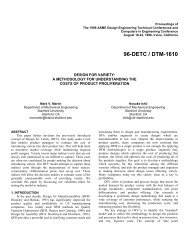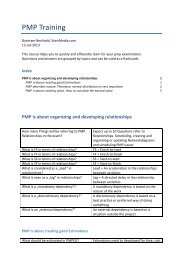Social Marketing
You also want an ePaper? Increase the reach of your titles
YUMPU automatically turns print PDFs into web optimized ePapers that Google loves.
Research 29<br />
Behavioral Science<br />
These questions are simple, but they are based upon some cornerstones of behavioral science.<br />
First, the questions about like and dislike are related to our growing understanding of how<br />
perceived consequences affect behavior. The second set (hard/easy) is related to self-efficacy<br />
- our feeling of adequacy to perform a new behavior. And finally, social norms suggest that<br />
people do things to please or follow people that they admire. So, the last two questions try to<br />
probe people’s feelings about those influencers. Here’s a simple way to remember these three<br />
determinants:<br />
Perceived consequences = FUN<br />
Self-efficacy = EASY<br />
<strong>Social</strong> norms = POPULAR<br />
Put simply, if you can find a way to make your new behavior fun, easy, and popular with your<br />
audience, you have a good chance of succeeding. But remember, what is “fun” for one person<br />
may be “work” for another. What is easy for one may be hard for another. And obviously, we<br />
all look to slightly different people for approval. Therefore, you need research to answer these<br />
questions adequately.<br />
Findings from applying behavioral science may require you to go back and refine your target<br />
audience. Suppose you want to address young women ages 18-24 but find out that they have<br />
nothing in common except that they don’t buy CFLs. However, you also learn that, at age 24,<br />
men are reading light bulb packages and learning to identify with a type of bulb they continue<br />
to embrace for years. You might re-define your target audience.<br />
Theory and Practice<br />
In the preceding paragraphs, we have described a good general approach to understanding<br />
a behavior. It is also important to examine three specific behavioral theories and what they<br />
bring to designing social marketing programs. These theories, social learning theory, stages<br />
of change, and diffusion of innovation, have all influenced the practice of social marketing and<br />
thinking about them in relation to your project can lead to valuable insights.<br />
<strong>Social</strong> Learning Theory (or the role of social norms)<br />
The social learning theory was developed by Albert Bandura in the 1970s, through his research<br />
on learning patterns and cognitive skills. In this theory, human behavior is explained in terms of<br />
a three-way dynamic in which personal factors, environmental influences, and other responses<br />
continually interact to influence behavior.<br />
<strong>Social</strong> <strong>Marketing</strong> Behavior A Practical Resource for <strong>Social</strong> Change Professionals

















